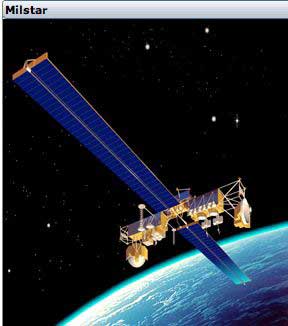
Witness the first Milstar II military communications satellite, built by a Lockheed Martin [NYSE: LMT] team for the U.S. Air Force, has surpassed its 10-year design life of on-orbit service, providing our nation's warfighters with secure and reliable communications since its successful launch on February 27, 2001. In addition to this 10-year milestone for Flight-4, the first two Milstar satellites have been on orbit for over 15 years — far exceeding their 10-year design life.
Designated Milstar II Flight-4, the satellite is the first of three Block II spacecraft on orbit that offer a variety of enhanced communications features for the U.S. military. In addition to the UHF and Low Data Rate EHF payload provided by Northrop Grumman Aerospace Systems of Redondo Beach, California, the satellite is equipped with a Medium Data Rate EHF payload built by Boeing Satellite Systems, El Segundo, California, which can process data at speeds up to 1.5 megabits per second. All Milstar satellites include crosslink payloads to communicate between on-orbit satellites “Built by a talented and dedicated team, this national asset has delivered exceptional service to our warfighters around the globe for the last decade.” said Kevin Bilger, vice president and general manager, Global Communications Systems, Lockheed Martin Space Systems in Sunnyvale. “The Milstar constellation has provided critical protected communications capabilities for our warfighters and will continue to make an important contribution to national security for many years to come.”
The five-satellite Milstar constellation, which has surpassed 58 years of combined successful operations, provides a protected, global communication network for the joint forces of the U.S. military and can transmit voice, data, and imagery, in addition to offering video teleconferencing capabilities.
The system is the principal survivable, endurable means that the President, the Secretary of Defense and the Commander, U.S. Strategic Command have to maintain positive command and control of the nation's strategic forces.
The new-generation Lockheed Martin-built Advanced EHF satellites will replace the Milstar constellation and increase data rates by a factor of five and the number of connections by a factor of two, permitting transmission of strategic and tactical military communications, such as real-time video, battlefield maps and targeting data. AEHF will be fully interoperable and backward compatible with Milstar Orbit-raising of the first AEHF satellite, launched successfully on Aug. 14, 2010, is proceeding and is on track to reach its geosynchronous slot this summer.
After reaching its intended orbit, the satellite's sophisticated communications payload will be activated and a detailed checkout will be completed before operational service is initiated by the Air Force.

